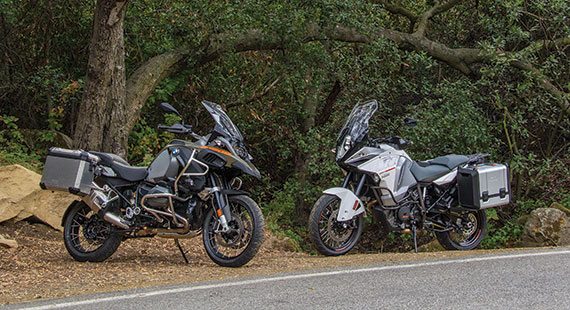
The last time we pitted the big BMW R 1200 GS Adventure against KTM’s then-largest ADV machine was in the August 2014 issue, and it wasn’t really a fair fight. The KTM 1190 Adventure is a well-equipped bike, but for an additional $5,000 or so, the BMW stacked the deck with a larger fuel tank, semi-active suspension, cruise control and shaft final drive vs. the KTM’s chain. The 1190 was slightly superior in the dirt, but the GSA’s additional features and greater comfort secured its place as the most capable and enjoyable bike in the comparo.
Well, the 1190 Adventure is no longer KTM’s largest ADV machine. That title now belongs to the 1290 Super Adventure, which levels the playing field with an equally large 7.9-gallon fuel tank, WP semi-active suspension and cruise control, in addition to its other myriad features—everything but shaft final drive. And that latter difference can be an advantage or a liability, depending upon whether you want the lighter weight and optimal power delivery of a chain, or the low-maintenance of a shaft.
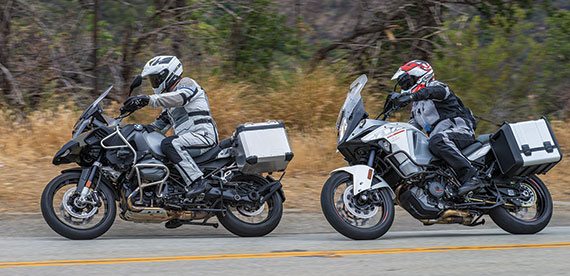
For this comparison we chose a BMW GSA equipped with the $3,355 Premium Package and $1,394 aluminum 44- and 36-liter cases, which brings its equipment level on par with the KTM’s for about $2,700 more total. If you’re willing to do without things like Dynamic ESA (semi-active electronically adjustable suspension), cruise control, heated grips, tire pressure monitors and more, you can get the BMW at similar cost. As equipped, similarities include large, one-hand adjustable windscreens, adjustable seat heights, fairing/engine crash bars, spoked tubeless 19- and 17-inch wheels, trip computers, and engine power and suspension modes that are changeable on the fly. The BMW has a few pounds more load capacity, but it also weighs 25 pounds more than the KTM with the cases installed.
Besides final drives, chief among the major differences between these two big travelers are the KTM V-twin’s greater horsepower, lighter weight, generally smaller bodywork proportions and shorter suspension travel, which helps lower its seat to a manageable 33.8 inches vs. the BMW’s 35 in their lower positions. (For 2015, BMW offers low suspension/low seat options for the GSA that could make the bike much more accessible for many riders.) On the Jett Tuning dyno, the BMW made 115.6 horsepower at 7,900 rpm at the rear wheel, and 82.4 lb-ft of torque at 6,700, numbers that the KTM bests with 136 rear-wheel horsepower at 9,300 and 86.1 lb-ft of torque at 6,900. The KTM also makes more torque down low and up high in its broader powerband, which, combined with its lighter weight and lower bulk, make it the performance choice on- or off-road. It’s not small by any stretch, and in fact has a longer wheelbase, but it is more compact than the BMW and therefore a bit easier to climb on and off, push around and maneuver at low speeds, especially for those of us with average inseams. Both are about the same width across the cases in back, but the BMW is equally as broad in front with its boxer engine and wide handlebar, while the KTM is significantly slimmer.

Once underway, the BMW is still smoother, quieter and more comfortable. The KTM pulls a bit more smartly out of the corners and can absolutely howl when you give it the whip, but compared to the BMW it’s buzzier, still sounds overly mechanical and gets warmer in traffic. While the KTM 1290 is definitely more comfortable than the 1190, it doesn’t quite offer the plushness of the BMW GSA’s stock seat, substantial wind protection and roomy ergonomic triangle (though heated seats are standard on the KTM). The semi-active suspension, engine power modes and brakes perform equally well on both. But we missed having an Off-Road mode for the ABS on the KTM that modulates both wheels, rather than just the front—that and a more-confidence-inspiring feel overall give the BMW an advantage in the dirt. We also wished the KTM would automatically change the suspension damping and ABS modes when the engine power mode is changed like the BMW. The KTM does have Combined ABS that works in corners, however, a huge plus, along with Motorcycle Stability Control that automatically varies the traction control level—the BMW’s must be set manually. Motor Slip Reduction (MSR) and Hill Hold Control (HHC) are also KTM options.
Overall, KTM has closed the gap between its top-of-the-line adventure tourer and BMW’s. For many riders, the choice really boils down to cost and chain vs. shaft, since the refinement level of the ride that each provides is very close.
Read our full road test of the 2015 KTM 1290 Super Adventure HERE.
2015 BMW R 1200 GS Adventure
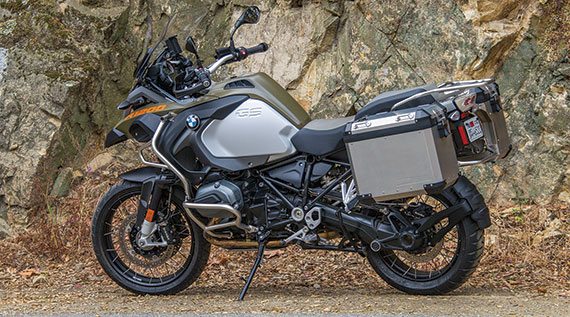
Base Price: $18,340
Price as Tested: $23,189 (premium package, Olive Green Metallic Matte, saddlebags w/ lock sets)
Warranty: 3 yrs., 36,000 miles
Website: bmwmotorcycles.com
Engine
Type: Air/liquid-cooled, longitudinal flat opposed twin
Displacement: 1,170cc
Bore x Stroke: 101.0 x 73.0mm
Compression Ratio: 12.5:1
Valve Train: DOHC, 4 valves per cyl.
Valve Insp. Interval: 12,000 miles
Fuel Delivery: BMS-X EFI w/ 52mm throttle bodies x 2
Lubrication System: Wet sump, 4.2-qt. cap.
Transmission: 6-speed, hydraulically actuated wet slipper clutch
Final Drive: Shaft, 2.91:1
Electrical
Ignition: Digital electronic
Charging Output: 510 watts max.
Battery: 12V 11.8AH
Chassis
Frame: Tubular-steel space frame w/ engine as stressed member & tubular-steel subframe; Paralever cast aluminum single-sided swingarm
Wheelbase: 59.4 in.
Rake/Trail: 24.5 degrees/3.6 in.
Seat Height: 35.0/35.8 in. (optional low seat, 33.1/33.9 in.)
Suspension, Front: Telelever w/ Sachs single shock, Dynamic ESA (as tested) & 8.3-in. travel
Rear: Sachs Single shock w/ Dynamic ESA (as tested) & 8.7-in. travel
Brakes, Front: Dual 305mm floating discs w/ opposed 4-piston calipers & ABS (linked to rear)
Rear: Single 276mm disc w/ 2-piston floating caliper & ABS
Wheels, Front: Spoked aluminum, 3.00 x 19 in.
Rear: Spoked aluminum, 4.50 x 17 in.
Tires, Front: 120/70-R19
Rear: 170/60-R17
Wet Weight: 623 lbs. (as tested)
Load Capacity: 433 lbs. (as tested)
GVWR: 1,056 lbs.
Performance
Fuel Capacity: 7.9 gals., last 1.0 gal. warning light on
MPG: 89 PON min. (avg) 35.5
Estimated Range: 280 miles
Indicated RPM at 60 MPH: 3,250
2015 KTM 1290 Super Adventure
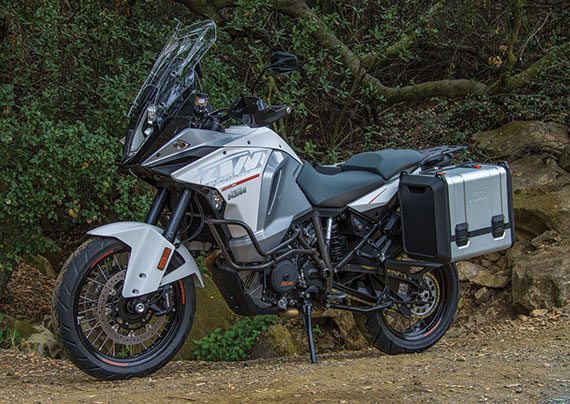
Base Price: $20,499
Price as Tested: $20,924 (MSR & HHC)
Warranty: 2 yrs., 24,000 miles
Website: ktm.com
Engine
Type: Liquid-cooled, transverse 75-degree V-twin
Displacement: 1,301cc
Bore x Stroke: 108.0 x 71.0mm
Compression Ratio: 13.1:1
Valve Train: DOHC, 4 valves per cyl.
Valve Insp. Interval: 18,600 miles
Fuel Delivery: Keihin EFI w/ 52mm throttle bodies x 2
Lubrication System: Dry sump, 3.8-qt. cap.
Transmission: 6-speed, hydraulically actuated wet slipper clutch
Final Drive: X-ring chain
Electrical
Ignition: Fully electronic w/ digital adj.
Charging Output: 450 watts max.
Battery: 12V 11.2AH
Chassis
Frame: Chrome-moly steel trellis w/ engine as stressed member & aluminum subframe; cast aluminum swingarm
Wheelbase: 61.4 in.
Rake/Trail: 26 degrees/4.7 in.
Seat Height: 33.8/34.4 in.
Suspension, Front: WP 48mm USD, semi-active w/ 7.9-in. travel
Rear: WP single shock, semi-active w/ 7.9-in. travel
Brakes, Front: Dual 320mm floating discs w/ opposed 4-piston calipers & ABS (linked to rear)
Rear: Single 267mm disc w/ 2-piston caliper & ABS
Wheels, Front: Spoked aluminum, 3.50 x 19 in.
Rear: Spoked aluminum, 5.00 x 17 in.
Tires, Front: 120/70-ZR19
Rear: 170/60-ZR17
Wet Weight: 598 lbs. (as tested)
Load Capacity: 416 lbs. (as tested)
GVWR: 1,014 lbs.
Performance
Fuel Capacity: 7.9 gals., last 1.06 gals. warning light on
MPG: 91 PON min. (avg) 37.0
Estimated Range: 292 miles
Indicated RPM at 60 MPH: 3,500

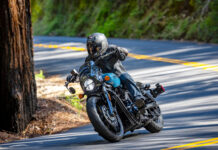






The KTM may be slimmer, but make no mistake, these are massive bikes made for people who like massive bikes. The new AT may redefine the class, assuming these are at all relevant to rtw adv travel .
The new AT may WHAT??!! Lol
forgot to tell that i have actually purchased the BMW after testing both..